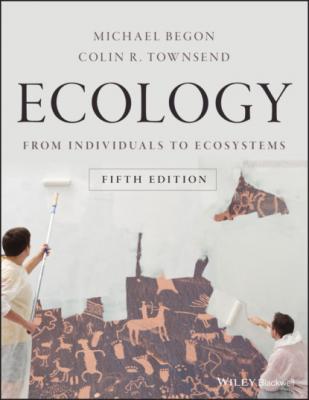Ecology. Michael Begon
Читать онлайн.| Название | Ecology |
|---|---|
| Автор произведения | Michael Begon |
| Жанр | Биология |
| Серия | |
| Издательство | Биология |
| Год выпуска | 0 |
| isbn | 9781119279310 |
Figure 5.14 Some dome‐shaped net‐recruitment curves. (a) Six‐month old brown trout, Salmo trutta, in Black Brows Beck, UK, between 1967 and 1989. (b) Wildebeest, Connochaetes taurinus, in the Serengeti, Tanzania 1959–95. (c) The relationship between crop growth rate of subterranean clover, Trifolium subterraneum, and population size (leaf area index) at various intensities of radiation (0.4–3 kJ cm−2 day−1).
Source: (a) After Myers (2001), following Elliott (1994). (b) After Mduma et al. (1999). (c) After Black (1963).
back to an integral projection model of Soay sheep
Finally here, we return to Figure 4.17, where integral projection models were used to combine density‐dependent patterns of growth, survival and fecundity for Soay sheep in Scotland in order to estimate how a population’s net reproductive rate will itself vary with abundance. We saw, as we have now come to expect, that as abundance increased the net reproductive rate, R, declined (Figure 4.17e). What is also apparent now is that ln R (= r) was equal to zero (R = 1) at a population size of around 455 sheep, which is therefore the predicted carrying capacity of the population, and an equilibrium, with positive values of ln R at population sizes smaller than this, but negative values at population sizes larger.
5.4.3 Sigmoidal growth curves
Curves of the type shown in Figure 5.13a and b may also be used to suggest the pattern by which a population might increase from an initially very small size (e.g. when a species colonises a previously unoccupied area). This is illustrated in Figure 5.13c. Imagine a small population, well below the carrying capacity of its environment (point A). Because the population is small, it increases in size only slightly during one time interval, and only reaches point B. Now, however, being larger, it increases in size more rapidly during the next time interval (to point C), and even more during the next (to point D). This process continues until the population passes beyond the peak of its net recruitment curve (Figure 5.13b). Thereafter, the population increases in size less and less with each time interval until the population reaches its carrying capacity (K) and ceases completely to increase in size. The population might therefore be expected to follow an S‐shaped or ‘sigmoidal’ curve as it rises from a low density to its carrying capacity. This is a consequence of the hump in its recruitment rate curve, which is itself a consequence of intraspecific competition.
Of course, Figure 5.13c, like the rest of Figure 5.13, is a gross simplification. It assumes, apart from anything else, that changes in population size are affected only by intraspecific competition. Nevertheless, something akin to sigmoidal population growth can be perceived in many natural and experimental situations (Figure 5.15).
Figure 5.15 Real examples of S‐shaped population increase. (a) The bacterium Lactobacillus sakei (measured as grams of ‘cell dry mass’ or CDM per litre) grown in nutrient broth. (b) The population of shoots of the annual plant Juncus gerardii in a salt marsh habitat on the west coast of France. (c) The population of the willow tree (Salix cinerea) in an area of land after myxomatosis had effectively prevented rabbit grazing.
Source: (a) After Leroy & de Vuyst (2001). (b) After Bouzille et al. (1997). (c) After Alliende & Harper (1989).
Intraspecific competition will be obvious in certain cases (such as overgrowth competition between sessile organisms on a rocky shore), but this will not be true of every population examined. Individuals are also affected by predators, parasites and prey, competitors from other species, and the many facets of their physical and chemical environment. Any of these may outweigh or obscure the effects of intraspecific competition; or the effect of these other factors at one stage may reduce the density to well below the carrying capacity for all subsequent stages. Nevertheless, intraspecific competition probably affects most populations at least sometimes during at least one stage of their life cycle.
APPLICATION 5.2 Human population growth and a global carrying capacity
The root of many of the environmental problems facing us is a large and growing global human population. More people means more competition: for renewable resources like fish and forests, for food production from agriculture, but also for energy, and non‐renewable resources like oil and minerals. During the first half of the 20th century, the global population increased by 40%, from 1.8 to 2.5 billion people. But since then the population has almost tripled to over seven billion. What’s more, the percentage of people living in cities has also grown steadily (Figure 5.16). By 2010, the number of city dwellers had equalled the number in rural environments for the first time in history, and the United Nations predicts that this trend will continue, with two‐thirds of the global population living in cities by 2050. The human population is growing ever larger and getting disproportionately crowded. We have seen through this chapter that the normal consequence, when populations grow, is that competition eventually slows that rate of growth and ultimately stops it, and that the overall size of the population settles, if not at a fixed carrying capacity, then within some regulated band. Is this what we’ve
